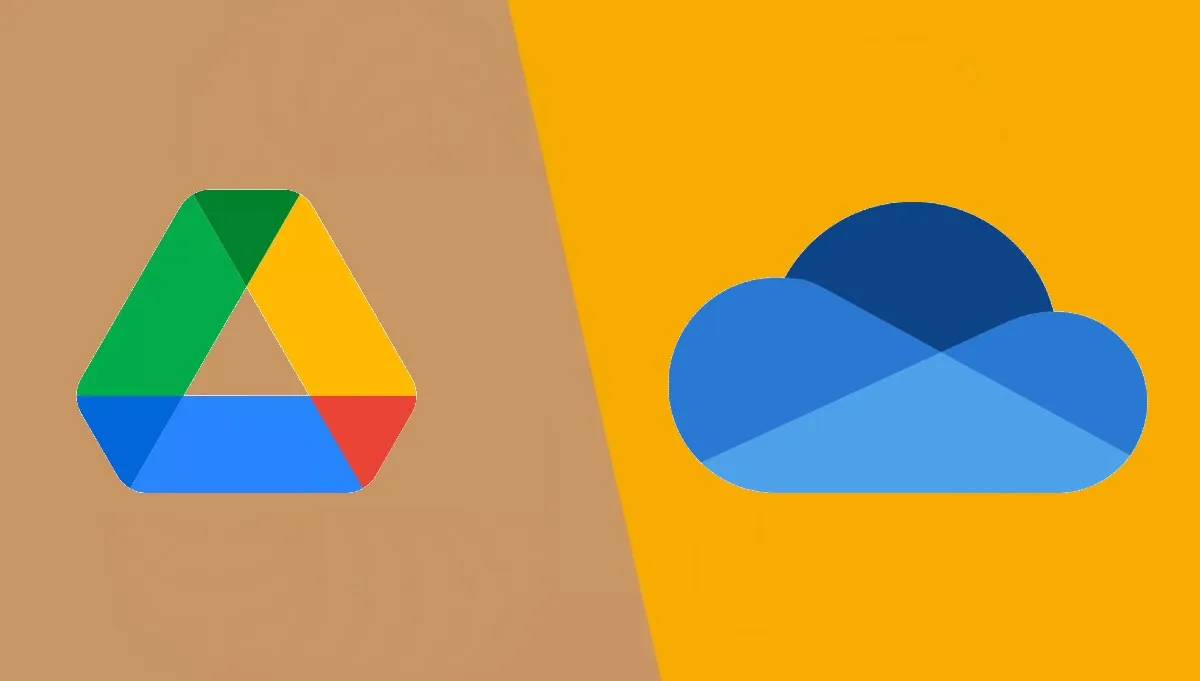Google Drive vs OneDrive: Which cloud solution is right for you?
 Google Drive is host to the majority of the cloud storage features that
individuals have come to expect. Even with the free plan, users get access to a
web interface, a mobile app, and sharing settings that can be adjusted at the
admin level. Microsoft OneDrive users will enjoy similar functionality,
including automatic syncing, where users indicate the files and folders they
want to be backed up, so they are automatically synced with copies in the cloud.
One of the biggest divides facing users when determining whether Google Drive or
OneDrive is the best fit for them concerns their operating system of
choice. ... Fans of Word, Excel, and the like, can still use Google Drive
but may have to convert documents into Docs, Sheets, and other Google-made
alternatives. That’s not a major issue but might affect how you perceive the
performance of each cloud solution. Although there’s not much to choose from in
terms of performance, it’s worth pointing out that Microsoft Office, which is
usually employed as an offline tool, will take up more storage space than Google
Workspace, which can be accessed via your web client. If storage is a major
concern for you, this might be worth keeping in mind.
Google Drive is host to the majority of the cloud storage features that
individuals have come to expect. Even with the free plan, users get access to a
web interface, a mobile app, and sharing settings that can be adjusted at the
admin level. Microsoft OneDrive users will enjoy similar functionality,
including automatic syncing, where users indicate the files and folders they
want to be backed up, so they are automatically synced with copies in the cloud.
One of the biggest divides facing users when determining whether Google Drive or
OneDrive is the best fit for them concerns their operating system of
choice. ... Fans of Word, Excel, and the like, can still use Google Drive
but may have to convert documents into Docs, Sheets, and other Google-made
alternatives. That’s not a major issue but might affect how you perceive the
performance of each cloud solution. Although there’s not much to choose from in
terms of performance, it’s worth pointing out that Microsoft Office, which is
usually employed as an offline tool, will take up more storage space than Google
Workspace, which can be accessed via your web client. If storage is a major
concern for you, this might be worth keeping in mind.
XaaS isn’t everything — and it isn’t serviceable
 BPOs and XaaS do share a characteristic that might, in some situations, be a
benefit but in most cases is a limitation, namely, the need to commoditize. This
requirement isn’t a matter of IT’s preference for simplification, either. It’s
driven by business architecture’s decision-makers’ preference for standardizing
processes and practices across the board. This might not seem to be an onerous
choice, but it can be. Providing a service that operates the same way to all
comers no matter their specific and unique needs might cut immediate costs but
can be, in the long run, crippling. Imagine, for example, that Human Resources
embraces the Business Services Oriented Architecture approach, offering up Human
Resources as a Service to its internal customers. As part of HRaaS it provides
Recruiting as a Service (RaaS). And to make the case for this transformation it
extols the virtues of process standardization to reduce costs. Imagine, then,
that you’re responsible for Store Operations for a highly seasonal retailer, one
that has to ramp up its in-store staffing from Black Friday through Boxing
Day.
BPOs and XaaS do share a characteristic that might, in some situations, be a
benefit but in most cases is a limitation, namely, the need to commoditize. This
requirement isn’t a matter of IT’s preference for simplification, either. It’s
driven by business architecture’s decision-makers’ preference for standardizing
processes and practices across the board. This might not seem to be an onerous
choice, but it can be. Providing a service that operates the same way to all
comers no matter their specific and unique needs might cut immediate costs but
can be, in the long run, crippling. Imagine, for example, that Human Resources
embraces the Business Services Oriented Architecture approach, offering up Human
Resources as a Service to its internal customers. As part of HRaaS it provides
Recruiting as a Service (RaaS). And to make the case for this transformation it
extols the virtues of process standardization to reduce costs. Imagine, then,
that you’re responsible for Store Operations for a highly seasonal retailer, one
that has to ramp up its in-store staffing from Black Friday through Boxing
Day.
Myth Busting: 5 Misconceptions About FinOps
 “FinOps is an evolving cloud financial management discipline and cultural
practice that enables organizations to get maximum business value by helping
engineering, finance, technology and business teams to collaborate on
data-driven spending decisions.” ... With traditional procurement models,
central teams retained visibility and control over expenditures. While this
would add layers of time and effort to purchases, this was accepted as a
worthwhile tradeoff. Part of the reason for FinOps has come into existence is
that it enables teams to break away from the rigid, centrally controlled
procurement models that used to be the norm. Rather than having a finance team
that acts as a central gatekeeper and bottleneck, FinOps enables teams to fully
leverage opportunities available for automation in the cloud. Compared to rigid,
monthly, or quarterly budget cycles—and being blindsided by cost overruns long
after the fact—teams move to continuous optimization. Real-time reporting and
just-in-time processes are two of the core principles of FinOps.
“FinOps is an evolving cloud financial management discipline and cultural
practice that enables organizations to get maximum business value by helping
engineering, finance, technology and business teams to collaborate on
data-driven spending decisions.” ... With traditional procurement models,
central teams retained visibility and control over expenditures. While this
would add layers of time and effort to purchases, this was accepted as a
worthwhile tradeoff. Part of the reason for FinOps has come into existence is
that it enables teams to break away from the rigid, centrally controlled
procurement models that used to be the norm. Rather than having a finance team
that acts as a central gatekeeper and bottleneck, FinOps enables teams to fully
leverage opportunities available for automation in the cloud. Compared to rigid,
monthly, or quarterly budget cycles—and being blindsided by cost overruns long
after the fact—teams move to continuous optimization. Real-time reporting and
just-in-time processes are two of the core principles of FinOps.
Selenium vs Cypress: Does Cypress Replace Selenium?
Cypress test framework captures snapshots during test execution. It enables QAs or software developers to hover over a precise command in the Command Log to notice exactly what happened at that specific phase. One does not require adding implicit or explicit wait commands in testing scripts, unlike Selenium. It waits for assertions and commands automatically. QAs or Developers can use Stubs, Clocks, and Spies to validate and control the behavior of server responses, timers, or functions. The automatic scrolling operation makes sure that the component is in view prior to performing any activity (for instance Clicking on a button). Previously Cypress supported only Google Chrome tests but, with current updates, Cypress now offers support for Mozilla Firefox as well as Microsoft Edge browsers. As the developers or programmer writes commands, this tool executes them in real-time, giving visual feedback as they run. It also carries brilliant documentation. Test execution for a local Se Grid can be ported to function with a cloud-based Selenium Grid with the least effort.5 Advanced Robotics And Industrial Automation Technologies
 One of the most critical advances in robotics and industrial automation
technologies is the development of autonomous vehicles. These vehicles can
drive themselves, making them safer and more efficient than traditional
vehicles. Autonomous vehicles can be used in a variety of ways. For example,
they can be used to transport goods around a factory. They can also be used
to help people search for objects or people. In all cases, autonomous
vehicles are much safer than traditional vehicles. As autonomous vehicles
become more common, they will significantly impact the automotive industry.
They will reduce the time people need to spend driving cars. They will also
reduce the number of accidents that happen on the road. ... One of the most
critical safety features of advanced robotics and industrial automation
technologies is their danger detection systems. These systems help to
protect workers from dangerous situations. One type of danger detection
system is the automatic emergency braking system. This system uses cameras
and sensors to detect obstacles on the road and brake automatically if
necessary.
One of the most critical advances in robotics and industrial automation
technologies is the development of autonomous vehicles. These vehicles can
drive themselves, making them safer and more efficient than traditional
vehicles. Autonomous vehicles can be used in a variety of ways. For example,
they can be used to transport goods around a factory. They can also be used
to help people search for objects or people. In all cases, autonomous
vehicles are much safer than traditional vehicles. As autonomous vehicles
become more common, they will significantly impact the automotive industry.
They will reduce the time people need to spend driving cars. They will also
reduce the number of accidents that happen on the road. ... One of the most
critical safety features of advanced robotics and industrial automation
technologies is their danger detection systems. These systems help to
protect workers from dangerous situations. One type of danger detection
system is the automatic emergency braking system. This system uses cameras
and sensors to detect obstacles on the road and brake automatically if
necessary.How to use the Command pattern in Java
 The Command pattern is one of the 23 design patterns introduced with the
Gang of Four design patterns. Command is a behavioral design pattern,
meaning that it aims to execute an action in a specific code pattern. When
it was first introduced, the Command pattern was sometimes explained as
callbacks for Java. While it started out as an object-oriented design
pattern, Java 8 introduced lambda expressions, allowing for an
object-functional implementation of the Command pattern. This article
includes an example using a lambda expression in the Command pattern. As
with all design patterns, it's very important to know when to apply the
Command pattern, and when another pattern might be better. Using the wrong
design pattern for a use case can make your code more complicated, not less.
We can find many examples of the Command pattern in the Java Development
Kit, and in the Java ecosystem. One popular example is using the Runnable
functional interface with the Thread class. Another is handling events with
an ActionListener.
The Command pattern is one of the 23 design patterns introduced with the
Gang of Four design patterns. Command is a behavioral design pattern,
meaning that it aims to execute an action in a specific code pattern. When
it was first introduced, the Command pattern was sometimes explained as
callbacks for Java. While it started out as an object-oriented design
pattern, Java 8 introduced lambda expressions, allowing for an
object-functional implementation of the Command pattern. This article
includes an example using a lambda expression in the Command pattern. As
with all design patterns, it's very important to know when to apply the
Command pattern, and when another pattern might be better. Using the wrong
design pattern for a use case can make your code more complicated, not less.
We can find many examples of the Command pattern in the Java Development
Kit, and in the Java ecosystem. One popular example is using the Runnable
functional interface with the Thread class. Another is handling events with
an ActionListener.Singleton Design Pattern in C# .NET Core – Creational Design Pattern
 The default constructor of the Singleton class is private, by making the
constructor private the client code has been restricted from directly
creating the instance of the Singleton class. In absence of the public
constructor, the only way to get the object of the Singleton class is to use
the global method to request an object i.e. the static GetInstance() method
in the Singleton class should be used to get the object of the class. The
GetInstance() method creates the object of the Singleton class when it is
called for the first time and returns that instance. All the subsequent
requests for objects to the GetInstance() method will get the same instance
of the Singleton class which was already created during the first
request. This standard implementation is also known as lazy instantiation as
the object of the singleton class is created when it is required i.e. when
there is a request for the object to the GetInstance() method. The main
problem with the standard implementation is that it is not thread-safe.
Consider a scenario where 2 different requests hit the GetInstances() method
at the same time so in that case, there is a possibility that two different
objects might get created by both the requests.
The default constructor of the Singleton class is private, by making the
constructor private the client code has been restricted from directly
creating the instance of the Singleton class. In absence of the public
constructor, the only way to get the object of the Singleton class is to use
the global method to request an object i.e. the static GetInstance() method
in the Singleton class should be used to get the object of the class. The
GetInstance() method creates the object of the Singleton class when it is
called for the first time and returns that instance. All the subsequent
requests for objects to the GetInstance() method will get the same instance
of the Singleton class which was already created during the first
request. This standard implementation is also known as lazy instantiation as
the object of the singleton class is created when it is required i.e. when
there is a request for the object to the GetInstance() method. The main
problem with the standard implementation is that it is not thread-safe.
Consider a scenario where 2 different requests hit the GetInstances() method
at the same time so in that case, there is a possibility that two different
objects might get created by both the requests.Here’s when to use data visualization tools, and why they’re helpful
 Successful data visualization tools will help you understand your audience,
set up a clear framework to interpret data and draw conclusions, and tell a
visual story that might not come off as clean and concise with raw data
points. Data visualization tools—when used properly—will help to better tell
a given story and make it possible to better pull information, see trending
patterns, and draw conclusions from large data sets. Data visualization
tools also lean into a more aesthetically pleasing approach to mapping and
tracking data. It goes beyond simply pasting information onto a pie chart
and instead uses design know-how, color theory, and other practices to
ensure information is presented in an interesting but easy-to-understand
manner. Although data visualization tools have always been popular in the
design space, the right data visualization tools can aid just about any
field of work or personal interest. For example, data visualization tools
can help journalists and editors track trending news stories to better
understand reader interest.
Successful data visualization tools will help you understand your audience,
set up a clear framework to interpret data and draw conclusions, and tell a
visual story that might not come off as clean and concise with raw data
points. Data visualization tools—when used properly—will help to better tell
a given story and make it possible to better pull information, see trending
patterns, and draw conclusions from large data sets. Data visualization
tools also lean into a more aesthetically pleasing approach to mapping and
tracking data. It goes beyond simply pasting information onto a pie chart
and instead uses design know-how, color theory, and other practices to
ensure information is presented in an interesting but easy-to-understand
manner. Although data visualization tools have always been popular in the
design space, the right data visualization tools can aid just about any
field of work or personal interest. For example, data visualization tools
can help journalists and editors track trending news stories to better
understand reader interest.9 Tips for Modernizing Aging IT Systems
 Once you’ve identified where the failures are in aging systems, compute the
costs in fixes, patches, upgrades, and add-ons to bring the system up to
modern requirements. Now add any additional costs likely to be incurred in
the near future to keep this system going. Compare the total to other
available options, including a new or newer system. “While this isn’t a
one-size-fits-all approach, the last 2.5 years have proven just how quickly
priorities can change,” says Brian Haines, chief strategy officer for
FM:Systems, an integrated workspace management system software provider.
“Rather than investing in point solutions that may serve the specific needs
of the organization today, a workplace tech solution that offers the ability
to add or even remove certain functions later to the same system means
organizations can more efficiently respond to ever-changing business,
employee, workplace, visitor and even asset needs going forward.” “This also
helps IT teams drastically reduce the time needed to shop for, invest in,
and deploy a separate solution that may or may not be compatible,” Haines
adds.
Once you’ve identified where the failures are in aging systems, compute the
costs in fixes, patches, upgrades, and add-ons to bring the system up to
modern requirements. Now add any additional costs likely to be incurred in
the near future to keep this system going. Compare the total to other
available options, including a new or newer system. “While this isn’t a
one-size-fits-all approach, the last 2.5 years have proven just how quickly
priorities can change,” says Brian Haines, chief strategy officer for
FM:Systems, an integrated workspace management system software provider.
“Rather than investing in point solutions that may serve the specific needs
of the organization today, a workplace tech solution that offers the ability
to add or even remove certain functions later to the same system means
organizations can more efficiently respond to ever-changing business,
employee, workplace, visitor and even asset needs going forward.” “This also
helps IT teams drastically reduce the time needed to shop for, invest in,
and deploy a separate solution that may or may not be compatible,” Haines
adds.CISA Post-Quantum Cryptography Initiative: Too Little, Too Late?
 Mike Parkin, senior technical engineer at Vulcan Cyber, a provider of SaaS
for enterprise cyber risk remediation, agreed that the move comes a little
late, but said CISA’s initiative is still a good step. “People have been
saying for years that the development of quantum computing would lead to the
end of cryptography as we know it,” he said. “With developments in the field
bringing us closer to a usable quantum computer, it’s past time to think
about how to deal with the future of cryptography.” He pointed out the
modern internet relies heavily on cryptography across the board, and quantum
computing has the potential to break a lot of that encryption, rendering it
effectively useless. “That, in turn, would effectively break many of the
internet services we’ve all come to rely on,” Parkin said. “Quantum
computing is not yet to the point of rendering conventional encryption
useless—at least that we know of—but it is heading that way.” He said he
believes the government is in the position to set encryption standards and
expectations for normal use and can work closely with industry to make sure
the standards are both effective and practical.
Mike Parkin, senior technical engineer at Vulcan Cyber, a provider of SaaS
for enterprise cyber risk remediation, agreed that the move comes a little
late, but said CISA’s initiative is still a good step. “People have been
saying for years that the development of quantum computing would lead to the
end of cryptography as we know it,” he said. “With developments in the field
bringing us closer to a usable quantum computer, it’s past time to think
about how to deal with the future of cryptography.” He pointed out the
modern internet relies heavily on cryptography across the board, and quantum
computing has the potential to break a lot of that encryption, rendering it
effectively useless. “That, in turn, would effectively break many of the
internet services we’ve all come to rely on,” Parkin said. “Quantum
computing is not yet to the point of rendering conventional encryption
useless—at least that we know of—but it is heading that way.” He said he
believes the government is in the position to set encryption standards and
expectations for normal use and can work closely with industry to make sure
the standards are both effective and practical.Quote for the day:
"It is better to fail in originality than to succeed in imitation." -- Herman Melville
No comments:
Post a Comment